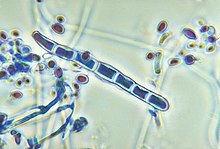Trichophyton
| Trichophyton | |
|---|---|

| |
| Trichophyton rubrum | |
| Scientific classification | |
| Domain: | Eukaryota |
| Kingdom: | Fungi |
| Division: | Ascomycota |
| Class: | Eurotiomycetes |
| Order: | Onygenales |
| Family: | Arthrodermataceae |
| Genus: | Trichophyton Malmsten |
Trichophyton is a
Species and their habitat preference
According to current classification, the genus includes anthropophilic and zoophilic species.
| Name | Botanical author | Environment |
|---|---|---|
| Trichophyton benhamiae | (Ajello & S.L. Cheng) Y. Gräser & de Hoog (2018) | zoophilic |
| Trichophyton bullosum | Lebasque (1933) | zoophilic |
| Trichophyton concentricum | R. Blanch. (1895) | anthropophilic
|
Trichophyton equinum
|
Gedoelst (1902) | zoophilic (horse) |
| Trichophyton erinacei | (J.M.B. Smith & Marples) Quaife (1966) | zoophilic (hedgehog) |
| Trichophyton eriotrephon | Papeg. (1925) | |
| Trichophyton mentagrophytes | (C.P. Robin) Sabour. (1895) | zoophilic (hedgehog) |
| Trichophyton quinckeanum | (Zopf ex Guég.) D.M. MacLeod & Muende (1940) | zoophilic (mouse) |
| Trichophyton rubrum | (Castell.) Sabour. (1911) | anthropophilic
|
Trichophyton schoenleinii
|
(Lebert) Langeron & Miloch. ex Nann. (1934) | anthropophilic
|
| Trichophyton simii | (Pinoy) Stockdale, D.W.R. Mack. & Austwick (1965) | zoophilic (monkey, fowl) |
Trichophyton soudanense
|
Joyeux (1912) | anthropophilic
|
| Trichophyton tonsurans | Malmsten (1848) | anthropophilic
|
| Trichophyton verrucosum | E. Bodin (1902) | zoophilic (cattle, horse) |
Trichophyton violaceum
|
Sabour. ex E. Bodin (1902) | anthropophilic
|
Other accepted species;[2]
- Trichophyton ajelloi(Vanbreus.) Ajello (1968)
- Trichophyton areolatum Negroni (1929)
- Trichophyton balcaneum Castell. (1919)
- Trichophyton batonrougei Castell. (1939)
- Trichophyton brumptii (Langeron & Baeza) N. Ansari & Faghih (1951)
- Trichophyton candelabrum Listemann (1973)
- Trichophyton cerebriforme Sabour. (1910)
- Trichophyton circonvolutum Sabour. (1910)
- Trichophyton denticulatum Sabour. (1910)
- Trichophyton depressum L. MacCarthy (1925)
- Trichophyton farinulentum Sabour. (1910)
- Trichophyton fischeri J. Kane (1977)
- Trichophyton flavescens A.A. Padhye & J.W. Carmich. (1971)
- Trichophyton floriforme Beintema (1934)
- Trichophyton fluviomuniense Pereiro (1968)
- Trichophyton fuligineum S. Ogata (1929)
- Trichophyton glabrum Sabour. (1910)
- Trichophyton gloriae Ajello (1967)
- Trichophyton gourvilii Catanei (1933)
- Trichophyton guzzonii Castell. (1939)
- Trichophyton immergens Miloch. (1937)
- Trichophyton indicum (Castell.) Nann. (1934)
- Trichophyton indotineae R. Kano, U. Kimura, M. Kakurai, J. Hiruma, H. Kamata, Y. Suga & K. Harada (2020)
- Trichophyton kanei Summerb. (1987)
- Trichophyton krajdenii J. Kane, J.A. Scott & Summerb. (1992)
- Trichophyton kuryangei Vanbreus. & S.A. Rosenthal (1961)
- Trichophyton longifusum (Flórián & Galgoczy) Ajello (1968)
- Trichophyton louisianicum Castell. (1927)
- Trichophyton mariatii Tap. Foss., Mizrachi, A.A. Padhye & Ajello (1980)
- Trichophyton megninii R. Blanch. (1895)
- Trichophyton milochevitchii (Langeron & Baeza) N. Ansari & Faghih (1951)
- Trichophyton multicolor O. Magalh. & J.A. Neves (1927)
- Trichophyton oceanicum Dompm., Drouhet & C. Moreau (1976)
- Trichophyton ochoterenai (Cif.) Nann. (1934)
- Trichophyton olexae Shohei Watan. (1977)
- Trichophyton pedis M. Ota (1922)
- Trichophyton plurizoniforme (L. MacCarthy) Rippon (1988)
- Trichophyton pratense Szathmáry (1941)
- Trichophyton proliferans M.P. English & Stockdale (1968)
- Trichophyton pseudotonsurans Biguet, G. Cochet, Deblock, Andrieu & Duc (1960)
- Trichophyton purpureum H. Bang (1910)
- Trichophyton radicosum Catanei (1937)
- Trichophyton raubitschekii J. Kane, Salkin, Weitzman & Smitka (1981)
- Trichophyton rotundum L. MacCarthy (1925)
- Trichophyton sabouraudii R. Blanch. (1895)
- Trichophyton sarkisovii L.G. Ivanova & I.D. Poljakov (1983)
- Trichophyton spadix (Y. Katô) Nann. (1934)
- Trichophyton teheraniense Ožeg. (1973)
- Trichophyton tenuishyphum Castell. (1939)
- Trichophyton vanbreuseghemii Rioux, Jarry & Juminer (1965)
Mating and meiosis
Trichophyton mentagrophytes (Family Arthrodermataceae, Genus Trichophyton) is capable of both mating[3] and meiosis.[4]
Effect on humans
The
Trichophyton concentricum causes "Malabar itch", a skin infection consisting of an eruption of a number of concentric rings of overlapping scales forming
Trichophyton rubrum and Trichophyton interdigitale cause athlete's foot (tinea pedis),
The fungi can easily spread to other areas of the body as well and to the host's home environs (socks, shoes, clothes, showers, bathtubs, counters, floors, carpets, etc.).They can be transmitted by direct contact, by contact with infested particles (of dead skin, nails, hair) shed by the host, and by contact with the fungi's spores. These fungi thrive in warm moist dark environments, such as in the dead upper layers of skin between the toes of a sweaty foot inside a tightly enclosed shoe, or in dead skin particles on the wet floor of a communal (shared) shower. Their spores are extremely difficult to eliminate, and spread everywhere.
When the
Treatments
A variety of zoophilic and anthropophilic dermatophyte treatments have varying levels of success based on species type. Treatments may take up to six months.[8]
References
- PMID 27783317.
- ^ "Trichophyton - Search Page". www.speciesfungorum.org. Species Fungorum. Retrieved 2023-05-15.
- PMID 20716853.
- PMID 5679669.
- ^ "Malabar itch - definition from Biology-Online.org". Archived from the original on 2016-03-30. Retrieved 2008-06-17.
- PMID 29861637.
- PMID 31598432.
- S2CID 209165839.
